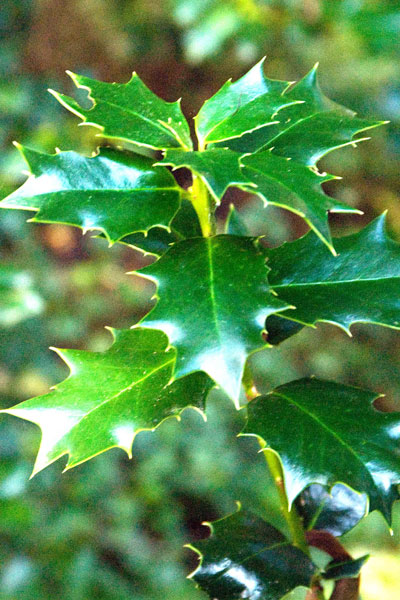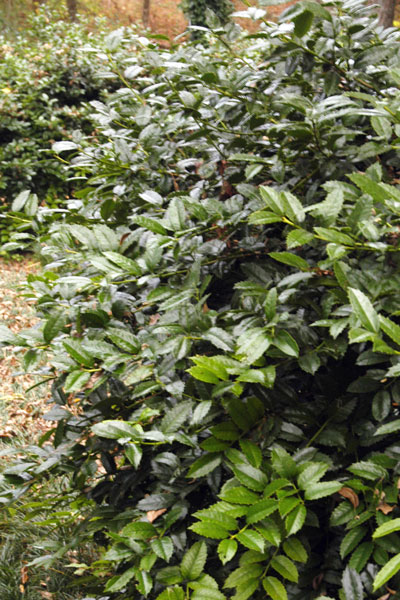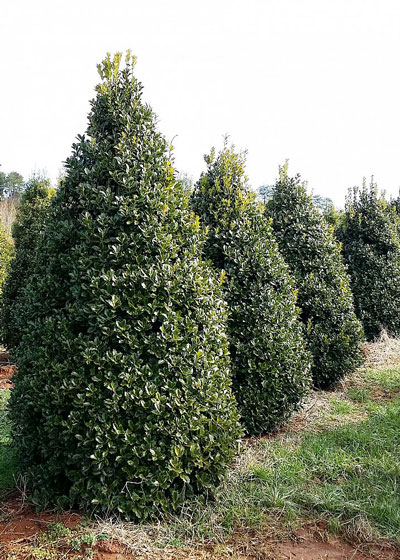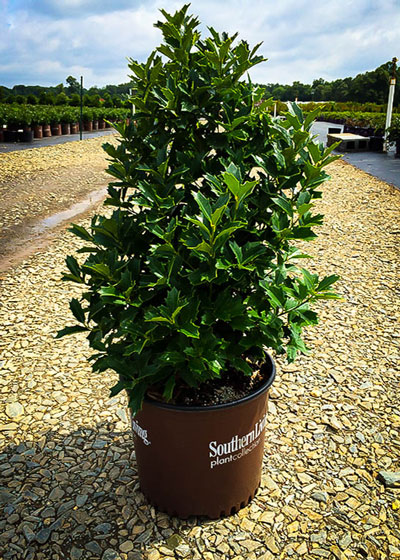Plant of the Week: Oakland Holly
Oakland holly is one of our finest tall, upright, evergreen shrubs for sun or shade and for big parts of Texas. It grows to 12 to 15 feet tall and 8 to 12 feet wide, although I’m sure it will exceed those sizes in the perfect growing conditions of East and Southeast Texas if you’re lucky enough to live and garden there.

This Oakland holly, perhaps broader than most, is framing its landscape. Photo by Neil Sperry.
Oakland hollies are suited to almost any Texas soils as long as they have a consistent supply of moisture. The plants don’t really wilt, so it’s easy for them to pass the permanent wilting point before you realize that they’re in serious distress. Water them by hand with a garden hose and water breaker for their first couple of years in your landscape. Growing them in rich, highly organic soils helps hold in the moisture.
They’re sold in all sizes in Texas nurseries, from 7- to 40-gallon pots and probably larger, so you can get instant gratification if that’s what you seek. If you’re using them as a screen, space the plants 6 to 8 feet apart in the row. If you’re using them to frame your front door, plant them 5 or 6 feet away from the walk and the house.
Little shearing will be needed to maintain their pyramidal form. Insects will rarely be a problem, and I’ve never seen a disease on any of the plants I’ve been around.

Evergreen leaves, 2 inches in length, have characteristic spines toward tip ends. Spines, however, are rarely sharp enough to inflict pain.
All the write-ups on Oakland hollies say that they bear showy orange-red berries each winter, but in the almost 20 years that I’ve been growing them I’ve not yet seen any fruit. However, it took that long before I saw any fruit on my Nellie R. Stevens and dwarf Chinese hollies, and now they bear every winter, so I’m willing to wait. The shrubs themselves would be enough if they never bore fruit.
A puzzling arrival…
It was back in the early 1990s that Mary Nell hollies became fairly common in the nursery trade. And then, almost immediately I saw a big display at the Texas Nursery and Landscape Association Expo in Houston of “seedlings of Mary Nell.” Almost before I had seen Mama Mary Nell fully grown in my gardens, here came the kids.

Mary Nell hollies growing in the Sperry backyard. These were the starting point.
Those offspring of Mary Nell were classed as “red” hollies, and Oak Leaf was one of the taller and prettier ones. I liked it, and I planted several in my landscape.

This photo of Oak Leaf hollies in a field at Orlando Tree Farms shows their very upright habit.
And then, seemingly only moments later, along came Oakland, looking for all the world like Oak Leaf and leaving me baffled as to what was happening.

Oakland holly is part of the impressive Southern Living Plant Collection. Again, you can see its upright habit of growth.
Then I found out that Oakland was a selection of Oak Leaf made from a branch sport on a plant at a wholesale nursery in southern Mississippi. It was propagated, named and patented, then introduced only a couple of years behind its maternal parent, and now it’s by far the more common.
If you’re looking for a plant to replace the disease-ridden Italian cypress or Blue Point junipers, Oakland hollies might be the one. And I might add, they make handsome living Christmas trees with lights in your yard.
